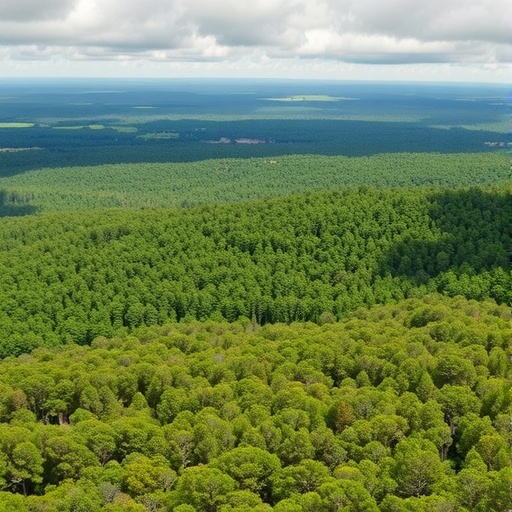New research reveals a stark future for Victoria’s iconic mountain ash forests, highlighting their rapid transformation from vital carbon sinks into significant carbon sources under the pressure of climate change. Published recently in Nature Communications, this study leverages nearly five decades of meticulous forest data to elucidate how increasing global temperatures are accelerating the demise of these towering ecosystems. The findings forecast a drastic reduction in tree density—nearly a quarter loss by 2080—fundamentally altering the role these forests play in carbon sequestration and climate regulation.
Mountain ash forests, dominated by Eucalyptus regnans, are among the Earth’s most potent ecosystems for carbon storage, surpassing even the Amazon in carbon density per hectare. These forests have long been pivotal in mitigating atmospheric carbon, absorbing vast quantities of CO₂ and thereby helping to regulate global climate systems. The new study, spearheaded by Dr. Raphael Trouve from the University of Melbourne, demonstrates that increasing temperatures are disrupting this equilibrium, triggering natural thinning processes that dramatically diminish the forests’ ability to lock in carbon over time.
The crux of the research reveals a delicate balance within these ecosystems, where warming intensifies competition for limited resources, most notably water. This environmental stress induces selective mortality, predominantly impacting smaller, less competitive trees struggling to survive amid water scarcity. The consequence is a natural “thinning” phenomenon, which while somewhat adaptive, significantly reduces overall forest biomass and carbon storage potential. This mechanism, intrinsic to the forests’ ecology, is set to exacerbate under projected climate scenarios.
Dr. Trouve emphasizes the exponential impact of these changes by correlating tree loss with temperature increments: for every additional degree Celsius of warming, around nine percent of the mountain ash population is lost. Given climate projections anticipating a rise of roughly three degrees by 2080, this portends a staggering 24 percent decrease in tree density—fundamentally altering forest structure and function in less than a century. This decline not only diminishes carbon uptake but also enhances carbon release as more biomass succumbs to decay.
The transformation of these forests into net carbon emitters carries profound implications. As dead trees decompose, they release stored carbon back into the atmosphere, effectively negating the benefits accumulated over decades or centuries of growth. Dr. Trouve quantifies this effect by equating it to vehicular emissions, noting that the carbon released could be likened to driving one million cars 10,000 kilometers annually for 75 years. This analogy underscores the scale of the environmental impact, providing a tangible measure of the lost carbon sequestration capabilities.
Furthermore, the study underscores that these projections do not yet incorporate the additional ravages of increased bushfire frequency and intensity, which climate change is also likely to exacerbate. Wildfires can cause abrupt, large-scale mortality, further accelerating carbon release and forest degradation. Thus, the combined pressures of heat stress, water limitation, and fire present a formidable threat to the longevity and health of mountain ash ecosystems.
Water cycle dynamics are an integral dimension of this research. Natural thinning, driven by competition for moisture, has cascading effects on regional water yields. Thinning reduces transpiration and water uptake by the forest, potentially altering streamflow and groundwater recharge — factors critical to water availability for human consumption, agricultural use, and ecosystem stability. Dr. Trouve cautions that continued forest decline could jeopardize water resources, including those vital to Melbourne’s urban supply.
In response to these challenges, forest management strategies are beginning to consider proactive measures such as selective thinning. By deliberately reducing stand density, foresters may relieve competitive stress among remaining trees, reallocating scarce water and nutrients to enhance individual tree resilience and growth rates. This intervention, he explains, could mimic the forest’s natural self-thinning processes but at an accelerated pace, potentially bolstering the overall health and carbon sequestration capacity of these ecosystems in the short to medium term.
Globally, thinning practices have demonstrated promising outcomes in increasing drought resistance and improving forest vitality during periods of environmental stress. This insight offers a pragmatic pathway for conservationists and land managers aiming to sustain mountain ash forests amid changing climatic conditions. While not a comprehensive solution, it serves as a vital buffer against the worst outcomes predicted by climate models.
The mountain ash, native to southeastern Australia, stands among the tallest tree species worldwide, with specimens exceeding 90 meters in height. Its prominence in the landscape and critical ecological role have made it a focus of intense scientific interest and conservation efforts. This research, supported by the Australian Research Council’s Discovery Project on forest carrying capacities amid climate change, adds a significant layer of understanding to how one of the planet’s tallest angiosperms faces existential risks from warming.
Dr. Trouve concludes with a call to recognize that forest thinning responses and their implications are not uniform globally but vary with regional climates and tree species traits. This variability underscores the complexity of projecting forest futures and tailoring conservation efforts accordingly. The study pushes the scientific community toward refining models that integrate physiological, ecological, and climatic variables to forecast and mitigate forest carbon dynamics more accurately.
This groundbreaking work profoundly reshapes our perception of forest carbon budgets. By illustrating the shift from carbon sinks to sources, it forces a reconsideration of large-scale afforestation and reforestation initiatives aimed at climate mitigation. Without addressing underlying thermal stressors and forest health, such strategies may fall short, underscoring the necessity for integrated approaches combining climate action, forest management, and ecological resilience building.
Subject of Research: Not applicable
Article Title: Global warming reduces the carrying capacity of the tallest angiosperm species (Eucalyptus regnans)
News Publication Date: 21-Aug-2025
Web References:
References:
Trouve, R. et al. (2025). Global warming reduces the carrying capacity of the tallest angiosperm species (Eucalyptus regnans). Nature Communications. DOI: 10.1038/s41467-025-62535-x
Image Credits: University of Melbourne
Keywords:
Forest ecosystems, Climate change




